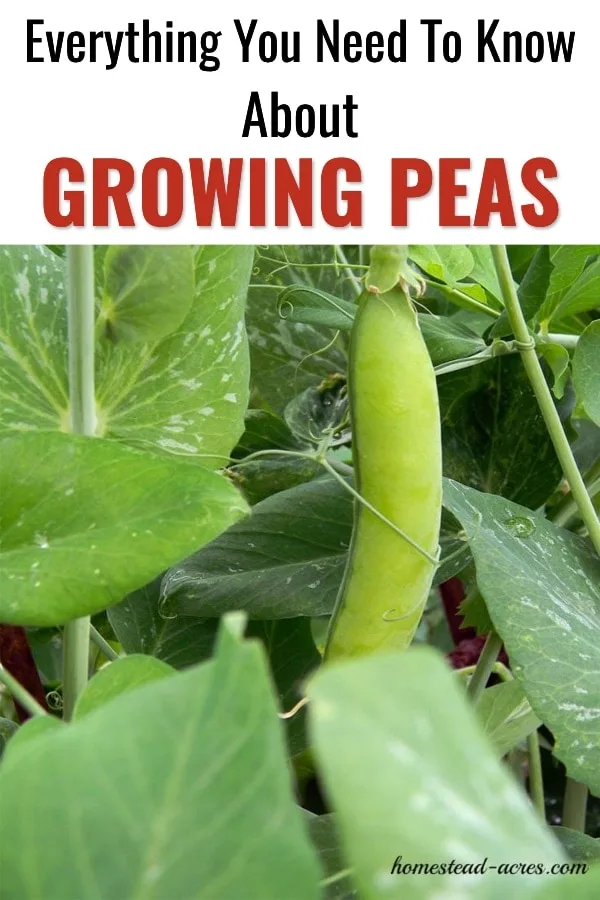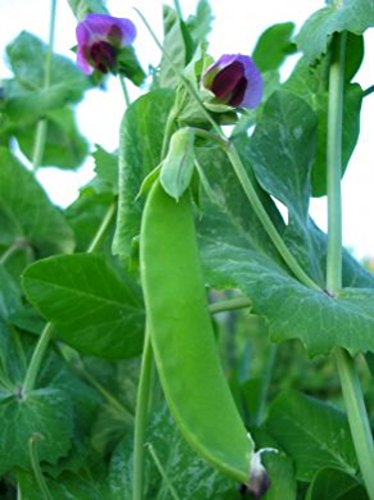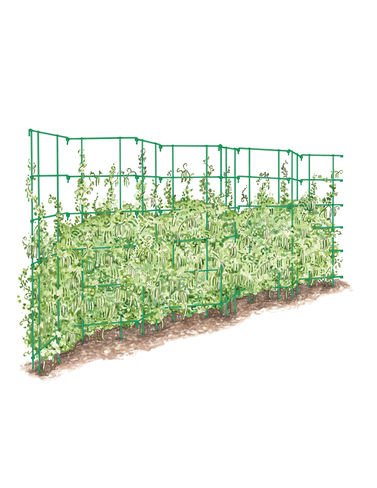This post may contain affiliate links, my full disclosure can be read here. As an Amazon Associate I earn from qualifying purchases.
Peas have to be one of our favorite vegetables and learning how to grow peas is so easy, they are sure to become a must have treat in your garden each year to!

I find myself planting more and more of these sweet vegetables each year because our children enjoy snacking on them out in the garden so much I rarely have enough to preserve for later in the year.
Types of Peas
There are 3 different varieties of peas you can grow in your garden.

Shell peas are sweet green peas that need to be shelled from tough, inedible pods. They are often called English peas because many varieties were developed in England during the 18th century.
Varieties of Shell Peas
25 Seeds Willet’s Wonder English Pea 50 GREEN ARROW PEA Heirloom Shelling English
50 GREEN ARROW PEA Heirloom Shelling English Everwilde Farms – 1 Lb Lincoln Shell Pea Seeds
Everwilde Farms – 1 Lb Lincoln Shell Pea Seeds Champion of England Shell Pea Seed
Champion of England Shell Pea Seed

Snap peas are a wonderful type of pea to grow in your home garden. The peas can be eaten whole, both the peas and pods are sweet and crunchy. These are a high yielding variety of peas.
David’s Garden Seeds Pea Sugar Sprint 200 Open Pollinated Seeds Pea Seed, Sugar Snap Pea, Heirloom, Organic, Non Gmo, 20+
Pea Seed, Sugar Snap Pea, Heirloom, Organic, Non Gmo, 20+ 200 Sugar Snap Pea Seeds Non-gmo,heirloom Seeds
200 Sugar Snap Pea Seeds Non-gmo,heirloom Seeds

Snow peas produce very tender, flat pods that can be eaten whole. These pea pods are harvested when very young when the peas inside are just starting to form. They are a wonderful addition to stir fries and salads.
Learn all about growing snow peas here!
Varieties of Snow Peas
Seeds of Change Certified Organic Pea, Sugar Pod 2 – 12 grams, 50 Seeds Pack Pea Avalanche Snow Pea DGS3040ZW (Green) 200 Open Pollinated Seeds
Pea Avalanche Snow Pea DGS3040ZW (Green) 200 Open Pollinated Seeds Swiss Giant Snow Pea Seeds- 20+ Seeds by Ohio Heirloom Seeds
Swiss Giant Snow Pea Seeds- 20+ Seeds by Ohio Heirloom Seeds
How To Grow Peas
When to Plant Peas
Peas are best planted in the early spring as soon as the soil can be worked, 4 to 6 weeks before your last frost date.
The best soil temperature for germination is 10–20C (50–70F).
Pea seedlings won’t be hurt by a blanket of snow, but prolonged freezing temperatures could damage them. If you receive an unusual cold spell make sure to cover your peas with some heavy fabric row covers for insulation.
Agribon AG-19 Floating Row Crop Cover / Frost Blanket / Garden Fabric Plant Cover Agfabric Floating Row Cover and Plant Blanket, 0.55oz Fabric of 5x25ft for Frost Protection
Agfabric Floating Row Cover and Plant Blanket, 0.55oz Fabric of 5x25ft for Frost Protection Gardeneer By Dalen Harvest-Guard Seed Germination & Frost Protection Cover 5′ x 25′
Gardeneer By Dalen Harvest-Guard Seed Germination & Frost Protection Cover 5′ x 25′
If you live where summers are cool you can plant succession sowings 2 to 3 weeks apart. Peas do not produce well in hot weather so you will want to time your plantings so that the peas have finished producing before the summer heat sets in.
If you live in an area that has long, mild falls you can plant a Fall planting of peas in late July to mid August. The seeds won’t take long to sprout in the warm summer soil but will enjoy growing in the soon to cool fall air.
Supporting Pea Plants
There are many varieties of peas you can choose to grow in your garden. Some of these grow only a few feet tall and others can easily grow 6 feet high!
While the taller varieties of peas must be supported with a trellis it’s also a good idea to provide support to the shorter types. Peas have thin stems and will easy fall over on the ground when a strong wind comes up.
For shorter varieties of peas you can use tomato cages as a quick and easy trellis. Simply place the tomato cages into the garden or container and plan the peas around the base of the cage.
Taller pea plants need a strong trellis. Chicken wire,fence wire, or strong plastic netting can all make excellent supports for pea plants. Make sure to use strong wooden stakes or PVC pipe to anchor the trellis.
Looking for easy to use garden trellis? Amazon has a wide range of styles at great prices!
Expandable Pea Trellis Heavy-Duty Nylon Tangle-Free Net
Heavy-Duty Nylon Tangle-Free Net Mesh Poultry Netting
Mesh Poultry Netting
How to Plant Peas
Although it’s not completely necessary to presoak your pea seed, I’ve found that it does get peas sprouting much faster.
The night before you plan to plant your peas place your seed into a wide mouth canning jar or shallow bowl. Then cover the pea seed with cool water.
You want to make sure the water is cool, not cold or hot. Water at temperature extremes can cause the pea seed to split open.
Let the pea seed soak for up to 24 hours. The peas will soak up a lot of water and this will help them to germinate much faster after being planted in your garden.
Peas grow best in a sunny area with well drained soil. Loosen your soil 8 to 10 inches deep and mix in some high quality compost. Using a hoe make a shallow furrow along both sides of your trellis.
Plant the pea seeds 2 inches apart and 1 inch deep into your prepared soil.
If you notice that after planting the pea seeds start to poke up through the dirt gently poke them back under or add a little soil over top of the seeds. This often happens if you receive a heavy rain that causes the seed to swell up and the dirt to erodes off the top.
Companion Planting For Peas
Good planting companions for peas are:
- beans
- carrots
- celery
- corn
- cucumbers
- eggplant
- parsley
- peppers
- potatoes
- radish
- spinach
- strawberries
- turnips
Avoid planting peas near:
- onions
Watering Peas
After planting your pea seed you’ll want to make sure you keep the ground moist but not soggy.
Peas need to absorb moisture to sprout but if they sit in soggy wet ground for to long the seed can rot. If wet soils are a big problem in your area try planting peas in raised beds or containers.
As your plants grow it’s important to keep them evenly watered, if they dry out the plants will stop producing peas.
How to Harvest Peas

The best way to keep from damaging your pea vines, is to use two hands to harvest the peas. Hold the vine just above the pea pod and gently pull it off the vine with your other hand.
When your pea plants are producing well you’ll want to harvest them daily to keep them producing. If you slow down on harvesting and allow the peas to grow to large the plant will slow down on flowering and making new pods.
The best time to harvest shell peas is when the pods start to show a waxy sheen, but before the green color has started to fade. The pods will be full and tender, once the color starts to fade from dark green to light green the peas start to get tough.
Snap peas can be picked when young and flat like snow peas or after they have almost matured. Both the peas and the pod will be very sweet when mature and you can eat them whole.
Snow peas are ready to pick when the pods are flat and the peas inside have barley started to form. They are sweet and crispy, perfect to enjoy raw or stir-fried.
After harvesting peas should be refrigerated as soon as possible to help keep them sweet and crisp. If you are growing peas for your food storage, you will want to blanch and freeze or can your peas as soon as possible.
How to Save Pea Seeds
Pea seeds are one of the easiest plants to save seeds from. Peas are self fertile plants and open pollinated. Saving seeds from your peas is as simple as allowing some of the pods to fully mature until the pods have turned brown.
Gently harvest the dry pea pods and remove the peas from inside and place on a tray lined with paper towels in a cool dry place indoors.
Allow them to finish drying there for a few weeks before storing. Pea seeds will stay viable for 3 years or longer.
More How To Grow Resources



Kim Mills is a homeschooling mom of 6 and lives on an urban homestead in Ontario, Canada. Blogging at Homestead Acres she enjoys sharing tips to help you save money, grow and preserve your own food.
















